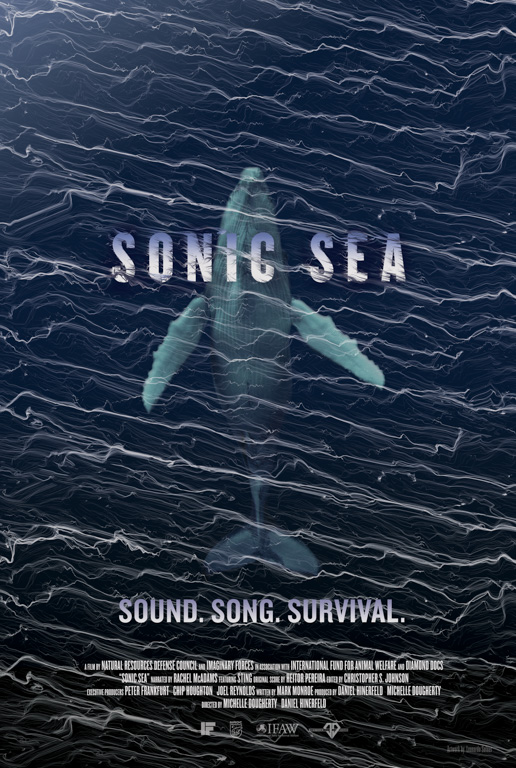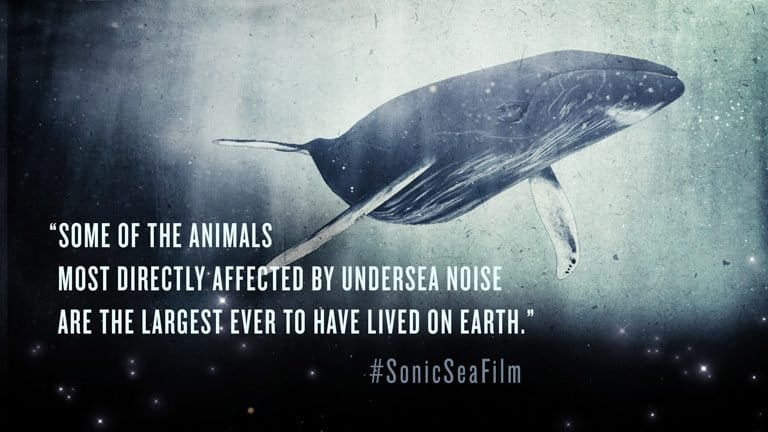- Sonar, air gun charges for oil and gas exploration, and ship traffic in the ocean can interfere with marine mammal communication, cause physiological problems and drive animals to strand on beaches.
- A new film, “Sonic Sea,” traces the risks of an increasingly noisy ocean to whales, dolphins and porpoises.
- The film is a finalist for the Best Science in Nature prize at the 2017 Jackson Hole Wildlife Film Festival in Jackson, Wyoming.
- The winners will be announced Sept. 28.
Animals in the world’s oceans have faced an ever-increasing cacophony in recent decades. They’re inundated with sonar intended to keep countries safe, air gun charges that help energy companies find new sources of oil and gas, and the sounds of the 60,000 commercial ships that ply the seas at any given time.
A new film called “Sonic Sea” by the Natural Resources Defense Council (NRDC) and Imaginary Forces catalogs the growing risks that noise poses to whales, dolphins, and porpoises and what scientists and conservationists are doing about it. It’s up for the Best Science in Nature prize at the 2017 Jackson Hole Wildlife Film Festival beginning Sept. 24 in Jackson, Wyoming.

Cetaceans, the group that includes whales, dolphins, and porpoises, depend on sound to communicate, to hunt and to avoid predators.
“The problem is, in the ocean, we are injecting enormous amounts of noise, so much so that we are basically acoustically bleaching the ocean,” said bioacoustician Christopher Clark of Cornell University in the film. “All the singing voices of the planet are lost in that cloud of noise.”
The recent uptick in sounds in the ocean has also been linked to lesions on cetaceans’ organs and hemorrhaging around their brains. It’s also been connected to mass strandings, in which large animals beach themselves, often with fatal consequences. Scientists suspect that they may be trying to get away from the disturbing noise.
During the film, Molly Patterson, a research assistant at OrcaLab in British Columbia, said that the din can sometimes give her and her colleagues a headache as they monitor nearby waters for the clicks and whistles of orca (Orcinus orca) pods. It sometimes forces them to take their headphones off, she said, which is a luxury their study subjects don’t have.
“They can’t turn the volume down,” Patterson said.
Until now, this problem has mostly been “out of sight, out of mind” for us humans, said Paul Spong, who directs OrcaLab. But the filmmakers of Sonic Sea hope that will change when audiences see these unintended consequences and how we can minimize the damage.
Mongabay discussed the story behind “Sonic Sea” with directors Daniel Hinerfeld of NRDC and Michelle Dougherty of Imaginary Forces by email.
Mongabay: What is your background and why did you make this film?
Hinerfeld: I grew up in Los Angeles, went to Vassar College and the London School of Economics and then started working as a journalist for outlets such as Rolling Stone, the Washington Post, the Los Angeles Times and other publications. In the early 1990s, I started reporting and producing for NPR. Since 2003, I’ve worked at NRDC, a large environmental advocacy organization, where I founded a film program in the mid-2000s. I made “Sonic Sea” to raise awareness about the devastating impact of ocean noise pollution, and to let people know that we can and must solve the problem.
Dougherty: My background is in design and commercial directing, I [am a graduate of] the Art Center College of Design in Pasadena, California, and I am currently a director at the creative company Imaginary Forces. I wanted to make this film to illuminate an invisible problem — ocean noise pollution — because I thought it was an important issue that most people didn’t know about, because they can’t see it. I felt that by creating a film that was character-driven and using design to illustrate an otherwise invisible issue, we could grab the hearts and heads of our audiences, so they also would want to help make a change.
Mongabay: What was a highlight in making this film? What were the biggest challenges?
Hinerfeld: There were so many highlights to making the film! The main highlight was getting to work with the amazing cast and crew — ocean scientists and advocates such as Sylvia Earle, Paul Spong, Christopher Clark and Ken Balcomb. They’re brilliant, dedicated people who know so much about the natural world, and have done so much to protect it. Getting to meet and work with Sting and Rachel McAdams was wonderful too. They both opened themselves up and used their talent and fame to help protect the ocean. And the whales! Let’s not forget the whales, especially the orcas and humpbacks we saw and heard up-close while spending time with Paul Spong at his magical research station on Hanson Island, British Columbia. Besides the usual challenges of filmmaking (coming up with the money and keeping on schedule), the biggest challenge of making “Sonic Sea” was figuring out how to bring a hidden world of sound to life on film.
Dougherty: The highlights for me were working with all these super talented people — our editor, writer, directors of photography, designers, producers, composer and sound designers … It really takes a village to make a film! And the scientists who have dedicated their life’s work to studying whales — [they were] so inspiring to me, as well as the lawyers at NRDC that fight for their survival. This film is really THEIR story, and we were there to bring it to life.

Mongabay: During shooting, did you encounter resistance to the idea that the noisy ocean many have consequences for the animals that live there? If so, who or what groups of people disagreed with you?
Hinerfeld: We did not encounter that resistance. Even the two former senior members of the U.S. Navy who are in the film acknowledge that noise harms whales and other marine life and that the Navy needs to make accommodations for that in its training. Likewise, the shipping industry representative in the film acknowledges the problem and is helping push her industry toward solutions. That said, the fossil fuel industry refused to talk with us. We asked quite a few people at several major companies, and they didn’t respond. I doubt they accept the scientific fact that their noise is harming the ocean, but they apparently don’t believe in climate change either.
Dougherty: I only remember one person that I encountered while shooting people on the streets for one of the sequences we created. It was a man who said he was a scientist that said this — “Oh, the whales will adapt.” I thought to myself, What if they can’t adapt quickly enough? Will we wipe them out? Is it worth that risk?
Mongabay: Was there some point during the production process at which you realized that you were covering a critical issue that most people don’t know a lot about?
Hinerfeld: We knew from the beginning this was an important project because we had the advantage of working alongside NRDC advocates and scientists who are experts in the field. They showed us from the outset how serious a problem ocean noise pollution is, and we knew from personal experience that the issue was just totally beneath the radar. The general public didn’t know anything about it.
Mongabay: What do you hope audiences take away from Sonic Sea?
Hinerfeld: I hope people leave the film understanding that we’re harming the ocean with our reckless noise pollution and that we can and must solve the problem. I hope the film helps people realize that the ocean is part of us, that we are part of the ocean and that we cannot thrive unless the ocean thrives. I also hope audiences are moved by the film emotionally so that they talk about the issue with their friends, share the film and take steps in their lives to address the problem.
Dougherty: I hope that audiences understand the importance of helping these animals to survive. I hope they understand how incredible these animals are and the importance of having them on this Earth [and] that we can make a change for their survival.

Mongabay: How can people help tackle this problem of noise in the ocean?
Hinerfeld: The same kind of consumer changes that can help fight climate change also combat ocean noise: thinking about what we consume and where it comes from, consuming less, buying locally, moving away from fossil fuel-based transportation — all of these things will help reduce the sonic burden we put on the ocean. People can also become ocean noise activists by going to www.sonicsea.org, clicking “take action,” and signing up. That will enable NRDC and [the International Fund for Animal Welfare] (our partner on the film) to reach out when we need large numbers of people to support healthy ocean policies by signing petitions, calling or writing members of Congress and otherwise raising their voices to protect whales and other marine life. The oil and gas industry has a friend in [U.S. President] Donald Trump, and they’re moving fast to roll-back environmental protections, including bedrock laws that protect the ocean. Finally, people can help raise awareness by sharing Sonic Sea, especially with schools. If you’d like to get Sonic Sea into classrooms, email allie@rocofilms.com to gift the film and its study guide to your alma mater or your children’s school.
Mongabay: What’s next for you?
Hinerfeld: I’m working on a few non-film projects, but I hope my next film will be a documentary about climate change from the perspective of the U.S. military, which is extremely concerned about the consequences of a warming planet for its operations and its mission. I think a lot of Americans who don’t understand or believe in climate change trust the military and would see things differently if they saw the issue through the eyes of our soldiers.
Dougherty: I’m always working on a myriad of commercial work, as well as pitching content ideas to people who hopefully will help to create them. I would also like to team up with Daniel again to create this film on climate change.
Editor’s Note: This interview was edited for style and length.
Banner image of researchers conducting an autopsy on a female beaked whale in New Zealand by Avenue (Own work) CC BY-SA 3.0 or GFDL, via Wikimedia Commons.
FEEDBACK: Use this form to send a message to the author of this post. If you want to post a public comment, you can do that at the bottom of the page.
Follow John Cannon on Twitter: @johnccannon

